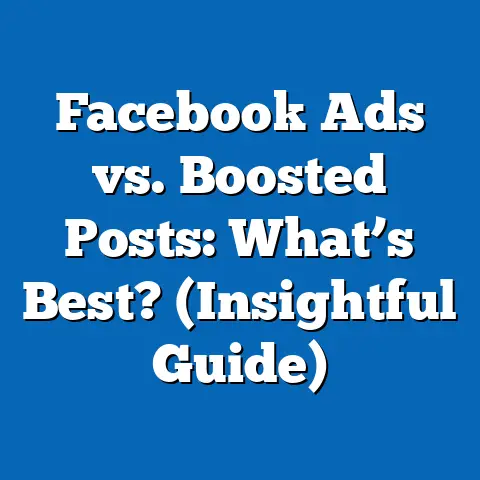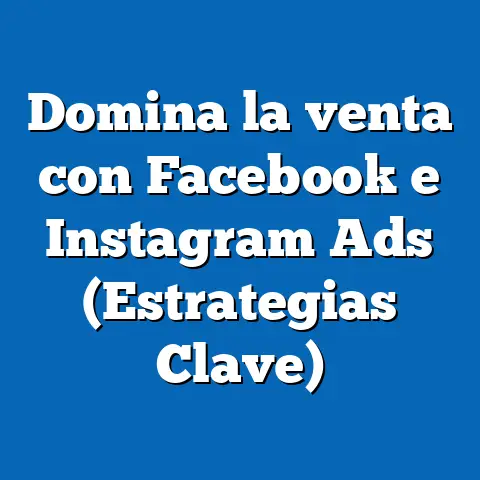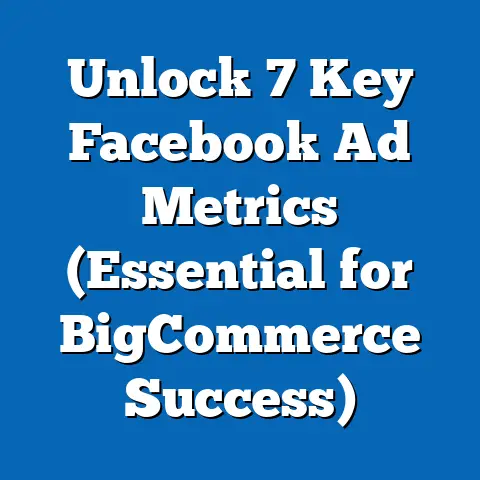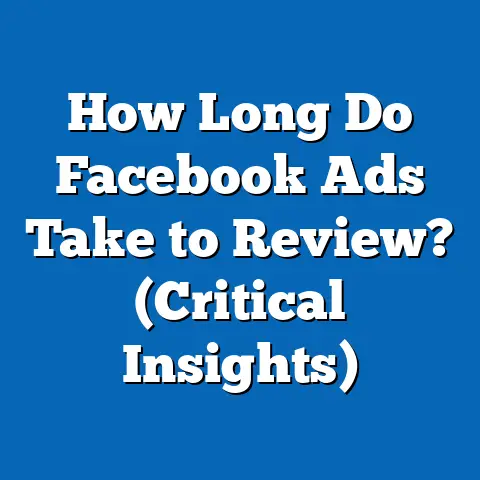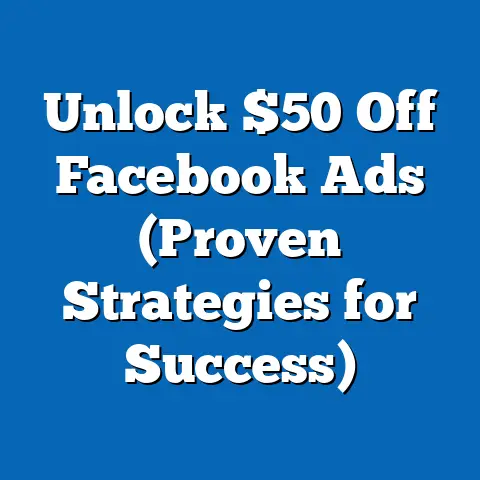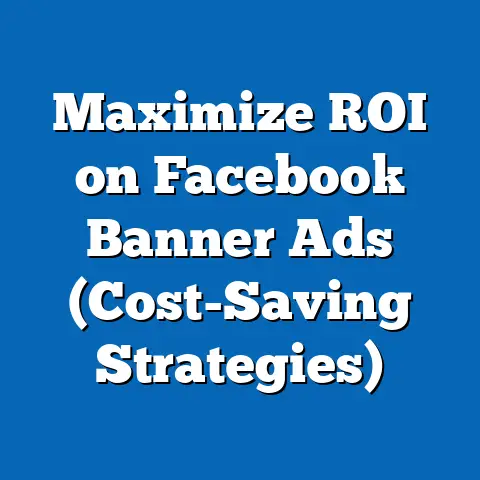Boost Facebook Video Ad Strategy (Proven Tactics)
Facebook. It’s a name synonymous with social connection, a platform that’s become as familiar as our own living rooms. For advertisers, this familiarity translates into a fertile ground for reaching audiences, especially with the power of video ads. I’ve seen countless businesses, from small startups to established enterprises, leverage Facebook’s ease of use and massive reach to connect with their ideal customers in ways that were unimaginable just a decade ago.
In today’s digital landscape, video isn’t just a trend; it’s a necessity. Think about your own online behavior. How often do you find yourself drawn to videos over static images or walls of text? I know I do! Statistics paint a clear picture: video content dominates social media consumption. According to a recent report, video ads are projected to account for over 80% of all internet traffic by 2024. That’s a staggering number, and it underscores the importance of having a robust Facebook video ad strategy.
The beauty of Facebook video ads lies in their versatility. Whether you’re a local bakery promoting your daily specials or a tech company launching a groundbreaking product, video ads offer a compelling way to tell your story, capture attention, and drive results. But simply creating a video and throwing it onto Facebook isn’t enough. To truly succeed, you need a strategic approach, a deep understanding of your audience, and a commitment to continuous optimization.
Understanding Facebook Video Ads
Definition and Types of Video Ads
What exactly are Facebook video ads? In essence, they are paid advertisements that utilize video content to promote a product, service, or brand on the Facebook platform. But the term “video ad” encompasses a wide range of formats, each with its own unique characteristics and advantages.
Let’s take a closer look at some of the most popular types of Facebook video ads:
- In-Stream Ads: These are short video ads that play within longer videos on Facebook Watch. Think of them as the digital equivalent of TV commercials. They’re typically 5-15 seconds long and offer a great way to reach viewers who are already engaged with video content.
- Story Ads: These immersive, full-screen video ads appear between users’ Stories on Facebook and Instagram. They’re perfect for capturing attention and creating a sense of immediacy. Story ads are often used for showcasing product demos, behind-the-scenes content, or limited-time offers.
- Carousel Video Ads: This format allows you to showcase multiple videos or images in a single ad unit. Users can scroll through the carousel to view different aspects of your product or service. Carousel video ads are ideal for storytelling and highlighting key features.
- Feed Ads: These are video ads that appear directly in users’ Facebook News Feeds. They blend seamlessly with organic content and can be highly effective at driving engagement. Feed ads are often used for brand awareness campaigns and driving traffic to websites.
- Collection Ads: These ads feature a primary video or image accompanied by a collection of product images below. When users click on the ad, they’re taken to a full-screen experience where they can browse and purchase products. Collection ads are particularly effective for e-commerce businesses.
The key difference between these video ad formats and traditional image ads is the dynamic, engaging nature of video. Video ads can convey more information, evoke stronger emotions, and create a more memorable experience for viewers.
Why Video Ads Matter
So, why should you prioritize video ads over other ad formats on Facebook? The answer is simple: they work. Numerous studies have shown that video ads outperform image ads in terms of engagement, conversion rates, and brand awareness.
Here are just a few reasons why video ads matter:
- Increased Engagement: Videos are inherently more engaging than static images or text. They capture attention, hold interest, and encourage interaction.
- Higher Conversion Rates: Video ads can effectively showcase the benefits of your product or service and persuade viewers to take action. Studies have shown that video ads can lead to significant increases in conversion rates.
- Enhanced Brand Awareness: Video ads can help you build brand awareness by creating a memorable and emotional connection with your audience.
- Improved ROI: While video production can be more expensive than creating image ads, the higher engagement and conversion rates often translate into a better return on investment.
I’ve personally witnessed the transformative power of video ads in my own campaigns. For example, I once worked with a local restaurant that was struggling to attract new customers. We created a series of short, mouthwatering video ads showcasing their signature dishes and the vibrant atmosphere of the restaurant. The results were astounding. Website traffic increased by 40%, online orders doubled, and the restaurant saw a significant boost in overall revenue. This is just one example of how video ads can make a real difference for businesses of all sizes.
The bottom line is that video ads are no longer a luxury; they’re a necessity for businesses looking to succeed on Facebook. By understanding the different types of video ads and the reasons why they matter, you can start crafting a strategy that will drive results for your business.
Crafting Compelling Video Content
Understanding Your Audience
Before you even think about shooting a single frame of video, it’s crucial to understand your audience. Who are you trying to reach? What are their interests, needs, and pain points? What kind of content do they typically engage with on Facebook?
Think of it like this: you wouldn’t cook a gourmet meal for someone who only eats fast food, right? Similarly, you need to tailor your video content to the specific preferences and expectations of your target audience.
Fortunately, Facebook provides a wealth of tools and resources to help you gather valuable insights about your audience. One of the most powerful tools is Facebook Audience Insights. This free tool allows you to explore the demographics, interests, behaviors, and connections of your target audience. You can use it to identify potential customer segments, understand their online habits, and discover what kind of content resonates with them.
Here are some tips for utilizing Facebook Audience Insights:
- Start with a broad audience: Begin by defining a broad audience based on basic demographics like age, gender, and location.
- Explore interests: Use the “Interests” tab to explore the interests of your target audience. You can enter keywords related to your industry, product, or service to see what topics they’re interested in.
- Analyze behaviors: The “Behaviors” tab provides insights into the online behaviors of your target audience, such as their purchasing habits, device usage, and travel patterns.
- Examine connections: The “Connections” tab shows you what pages and groups your target audience is connected to. This can help you identify potential partners and influencers.
By using Facebook Audience Insights, you can gain a deep understanding of your target audience and create video content that is tailored to their specific needs and interests.
Storytelling in Video Ads
Once you understand your audience, it’s time to start crafting your video content. And one of the most effective ways to engage viewers is through storytelling.
Think about some of your favorite commercials. What makes them so memorable? Chances are, they tell a compelling story that resonates with you on an emotional level.
Storytelling is a powerful tool that can help you connect with your audience, build brand loyalty, and drive action. But how do you tell a story in a short video ad?
Here are some techniques for developing a narrative that resonates with viewers:
- Identify your core message: What is the one thing you want viewers to remember about your video ad?
- Create a relatable character: Who is the hero of your story? Make sure they are someone that your target audience can identify with.
- Establish a conflict: What is the challenge that your character is facing?
- Offer a solution: How does your product or service help your character overcome the challenge?
- End with a call to action: What do you want viewers to do after watching your video ad?
For example, let’s say you’re promoting a new fitness app. You could create a video ad that tells the story of someone who is struggling to get in shape. The character is frustrated with their lack of progress and feels discouraged. But then, they discover your fitness app and start using it regularly. They begin to see results and feel more confident and energized. The video ends with a call to action: “Download our fitness app today and start your transformation!”
By telling a compelling story, you can capture the attention of your audience, build an emotional connection, and inspire them to take action.
Visual and Audio Elements
While storytelling is important, it’s equally crucial to pay attention to the visual and audio elements of your video ad. Remember, you only have a few seconds to capture the attention of viewers, so your video needs to be visually appealing and aurally engaging.
Here are some tips for optimizing visuals and sound in video production:
- Use high-quality visuals: Make sure your video is well-lit, in focus, and visually appealing. Use professional-grade equipment and editing software to create a polished final product.
- Optimize for mobile viewing: Given that a significant percentage of Facebook users access the platform via mobile devices, it’s crucial to optimize your video for mobile viewing. Use a vertical or square aspect ratio to fill the screen and make sure the text is legible on smaller devices.
- Add captions: Many people watch videos on Facebook with the sound turned off, so it’s essential to add captions to your video. Captions not only make your video accessible to a wider audience but also help viewers understand the message even when the sound is off.
- Use engaging music: Music can play a powerful role in setting the tone and mood of your video ad. Choose music that is appropriate for your brand and target audience.
- Use sound effects: Sound effects can add another layer of engagement to your video. Use them sparingly to emphasize key moments and create a more immersive experience.
I remember working on a campaign for a travel agency that wanted to promote their luxury vacation packages. We created a stunning video ad featuring breathtaking scenery, luxurious accommodations, and exciting activities. However, the video was poorly lit and the sound quality was subpar. The result was a video that looked amateurish and failed to capture the attention of viewers. After re-shooting the video with professional equipment and paying closer attention to the visual and audio elements, we saw a significant improvement in engagement and conversion rates.
The lesson here is clear: don’t underestimate the importance of high-quality visuals and sound in video production. They can make or break your video ad campaign.
Optimization Techniques for Facebook Video Ads
Video Length and Format
You’ve crafted a compelling story, optimized your visuals and sound, and now it’s time to think about the technical aspects of your video ad. One of the most important decisions you’ll make is the length and format of your video.
So, what’s the ideal video length for Facebook ads? The answer, unfortunately, is “it depends.” There’s no one-size-fits-all answer, as the optimal length will vary depending on your target audience, your message, and your advertising goals.
However, as a general rule, shorter is better. In today’s attention-deficit world, viewers have a limited amount of time and patience. If your video is too long, they’re likely to tune out before you even get to the good stuff.
Here are some guidelines for video length:
- In-stream ads: 5-15 seconds
- Story ads: 15 seconds
- Feed ads: 15-60 seconds
It’s also important to grab attention within the first few seconds of your video. Studies have shown that viewers decide whether or not to continue watching a video within the first 3 seconds. So, make sure your opening is engaging, visually appealing, and relevant to your target audience.
In terms of format, Facebook supports a variety of video formats, including MP4, MOV, and AVI. However, MP4 is generally the preferred format, as it offers a good balance of quality and file size.
You’ll also need to choose an aspect ratio for your video. The most common aspect ratios are 16:9 (widescreen), 1:1 (square), and 9:16 (vertical).
- 16:9 (widescreen): This is the traditional aspect ratio for videos and is best suited for landscape-oriented content.
- 1:1 (square): This aspect ratio is ideal for mobile viewing and is often used for feed ads.
- 9:16 (vertical): This aspect ratio is perfect for Story ads and other mobile-first content.
The key is to choose an aspect ratio that is appropriate for your target audience and the platform you’re advertising on.
Thumbnails and Captions
Even if you’ve created a masterpiece of a video ad, it won’t get any views if it doesn’t have an eye-catching thumbnail. Think of your thumbnail as the cover of a book. It’s the first thing viewers will see, and it will determine whether or not they click to watch your video.
Here are some best practices for creating thumbnails that drive clicks and engagement:
Here are some tips for creating effective captions:
- Use accurate and concise language: Make sure your captions accurately reflect the spoken words in your video.
- Use proper grammar and punctuation: Errors in grammar and punctuation can make your video look unprofessional.
- Sync captions with the audio: Make sure your captions are synchronized with the audio so that viewers can easily follow along.
- Use different font sizes and colors: Experiment with different font sizes and colors to make your captions more visually appealing.
- Test different caption styles: Try different caption styles to see which ones perform best.
I once worked with a client who was hesitant to add captions to their video ads. They thought it would make their videos look cluttered and unprofessional. However, after conducting some A/B testing, we found that videos with captions had significantly higher engagement rates than videos without captions. The lesson here is that captions are not just an accessibility feature; they’re a powerful tool for driving engagement and improving the overall performance of your video ads.
Call to Action (CTA)
You’ve captured the attention of your audience, told a compelling story, and optimized your visuals and sound. Now it’s time to tell viewers what you want them to do. This is where the call to action (CTA) comes in.
A strong CTA is essential for driving conversions and achieving your advertising goals. It’s the final nudge that encourages viewers to take the desired action, whether it’s visiting your website, downloading your app, or making a purchase.
Here are the components of a strong CTA in video ads:
- Clarity: Your CTA should be clear and concise. Tell viewers exactly what you want them to do.
- Relevance: Your CTA should be relevant to your video content and your target audience.
- Urgency: Create a sense of urgency by using language like “limited time offer” or “shop now.”
- Visual appeal: Make sure your CTA is visually appealing and stands out from the rest of your video.
- Placement: Place your CTA strategically in your video, typically at the end or during key moments.
Here are some examples of effective CTAs:
- “Shop now and get 20% off!”
- “Download our app today!”
- “Visit our website to learn more.”
- “Sign up for our free trial.”
- “Contact us for a free consultation.”
The key is to experiment with different CTAs to see which ones perform best for your target audience and your advertising goals.
Targeting and Retargeting Strategies
Utilizing Facebook Ad Targeting Options
One of the biggest advantages of Facebook advertising is its powerful targeting options. Facebook allows you to target your video ads to specific audiences based on a variety of factors, including demographics, interests, behaviors, and connections.
Here’s a breakdown of the different targeting options available on Facebook:
- Demographic Targeting: Target your ads based on age, gender, location, education, and relationship status.
- Interest-Based Targeting: Target your ads based on the interests and hobbies of your target audience.
- Behavioral Targeting: Target your ads based on the online behaviors of your target audience, such as their purchasing habits, device usage, and travel patterns.
- Connection Targeting: Target your ads to people who are connected to your Facebook page or event.
- Custom Audiences: Create custom audiences based on your existing customer data, such as email addresses or phone numbers.
- Lookalike Audiences: Create lookalike audiences based on your existing customer data. Facebook will find people who are similar to your best customers.
To create custom audiences for your video ad campaigns, you can upload your customer data to Facebook or use the Facebook Pixel to track website visitors.
Here are some tips on how to create custom audiences:
- Segment your customer data: Segment your customer data based on demographics, purchasing behavior, or other relevant factors.
- Create multiple custom audiences: Create multiple custom audiences to target different segments of your customer base.
- Test different custom audiences: Experiment with different custom audiences to see which ones perform best.
I once worked with an e-commerce business that was struggling to generate sales from their Facebook ads. After analyzing their customer data, we discovered that their best customers were women aged 25-34 who were interested in fashion and beauty. We created a custom audience based on this data and targeted our video ads specifically to this group. The result was a significant increase in sales and a dramatic improvement in ROI.
The key to successful Facebook advertising is to experiment with different targeting options and custom audiences to see what works best for your business.
Retargeting Video Viewers
One of the most effective targeting strategies on Facebook is retargeting. Retargeting allows you to show ads to people who have already interacted with your video content or visited your website.
For example, you can retarget users who have watched at least 25% of your video ad. This allows you to show them a follow-up ad that is more targeted and relevant to their interests.
Here’s how to set up retargeting campaigns on Facebook:
- Create a custom audience: Create a custom audience based on people who have watched your video ad.
- Create a retargeting ad: Create a retargeting ad that is specifically designed for this audience.
- Target your ad to the custom audience: Target your retargeting ad to the custom audience you created in step 1.
The types of content to serve to these audiences will depend on their level of engagement with your previous video ad. For example, if someone watched 25% of your video, you might show them a follow-up ad that provides more information about your product or service. If someone watched 75% of your video, you might show them an ad that encourages them to make a purchase.
Retargeting is a powerful tool that can help you increase conversions and drive ROI from your Facebook video ads.
Measuring Success and Analyzing Performance
Key Metrics to Track
You’ve launched your Facebook video ad campaign, but how do you know if it’s working? The answer is to track the key performance indicators (KPIs) that are most relevant to your advertising goals.
Here are some of the key metrics to track for video ads:
- Views: The number of times your video ad has been viewed.
- Reach: The number of unique people who have seen your video ad.
- Frequency: The average number of times each person has seen your video ad.
- Engagement Rate: The percentage of people who have engaged with your video ad (e.g., liked, commented, shared).
- Click-Through Rate (CTR): The percentage of people who have clicked on your video ad.
- Conversion Rate: The percentage of people who have converted after clicking on your video ad (e.g., made a purchase, downloaded an app).
- Cost Per View (CPV): The average cost you pay for each view of your video ad.
- Return on Ad Spend (ROAS): The amount of revenue you generate for every dollar you spend on advertising.
Facebook provides a variety of tools for tracking these metrics, including Facebook Ads Manager and Facebook Analytics.
Adjusting Strategies Based on Data
Once you’ve collected enough data, it’s time to analyze your performance and make adjustments to your video ad strategies.
Here are some examples of adjustments that can be made based on performance data:
- If your views are low: Try experimenting with different thumbnails, headlines, or targeting options.
- If your engagement rate is low: Try creating more engaging video content or targeting a different audience.
- If your click-through rate is low: Try using a more compelling call to action or improving your ad copy.
- If your conversion rate is low: Try optimizing your landing page or simplifying the checkout process.
- If your cost per view is high: Try narrowing your targeting or bidding lower.
- If your return on ad spend is low: Try adjusting your targeting, ad copy, or landing page.
I remember working with a client who was running a Facebook video ad campaign to promote their new line of clothing. After analyzing their performance data, we discovered that their conversion rate was very low. We realized that their landing page was poorly designed and difficult to navigate. We redesigned their landing page to make it more user-friendly and easier to make a purchase. The result was a significant increase in conversion rates and a dramatic improvement in ROAS.
The key to successful Facebook advertising is to continuously monitor your performance data and make adjustments to your strategies as needed.
Advanced Tactics for Video Ads
Using Facebook Live for Engagement
Facebook Live is a powerful tool that can complement your video ad strategies and boost engagement. Facebook Live allows you to broadcast live video to your followers in real-time.
Here are some tips for incorporating live video into your broader video advertising strategy:
- Host Q&A sessions: Host live Q&A sessions with your audience to answer their questions and build relationships.
- Give behind-the-scenes tours: Give your audience a behind-the-scenes tour of your business or product.
- Interview industry experts: Interview industry experts to provide valuable insights to your audience.
- Host live product demos: Host live product demos to showcase the features and benefits of your products.
- Announce new products or services: Announce new products or services live to generate excitement and anticipation.
Facebook Live can be a powerful tool for building brand awareness, driving engagement, and generating leads.
Collaborations and Influencer Marketing
Influencer marketing can be a highly effective way to amplify your video ad campaigns and reach a wider audience. Influencers are people who have a large and engaged following on social media. By collaborating with influencers, you can tap into their audience and promote your products or services to a highly targeted group of people.
Here are some strategies for selecting and collaborating with influencers on Facebook:
- Identify relevant influencers: Identify influencers who are relevant to your industry and your target audience.
- Research their audience: Research the demographics, interests, and engagement of their audience.
- Reach out and build relationships: Reach out to influencers and build relationships with them.
- Develop a collaboration plan: Develop a collaboration plan that outlines the goals, deliverables, and compensation for the collaboration.
- Track your results: Track the results of your influencer marketing campaigns to measure their effectiveness.
I once worked with a beauty brand that collaborated with a popular beauty influencer on Facebook. The influencer created a series of video ads showcasing the brand’s products and sharing her personal experiences. The result was a significant increase in brand awareness, website traffic, and sales.
Influencer marketing can be a powerful tool for amplifying your video ad campaigns and reaching a wider audience.
Conclusion
In conclusion, boosting your Facebook video ad strategy requires a multifaceted approach. It’s not just about creating visually appealing videos; it’s about understanding your audience, crafting compelling stories, optimizing your ads for maximum engagement, and continuously analyzing your performance data.
Throughout this guide, we’ve explored proven tactics that can help you achieve these goals. From understanding the different types of video ads to mastering targeting strategies and leveraging advanced techniques like Facebook Live and influencer marketing, we’ve covered everything you need to know to create video ads that resonate with your audience and deliver tangible business results.
Remember, the key to success on Facebook is to continually evolve your strategies in response to viewer behavior and platform changes. By staying up-to-date with the latest trends and best practices, you can ensure that your video ads remain effective and continue to drive results for your business.
So, go forth and implement these tactics to enhance your Facebook video ad campaigns and drive better results. The world of video advertising is constantly evolving, but by embracing these strategies and remaining adaptable, you can unlock the full potential of Facebook video ads and achieve your marketing goals. Good luck!

